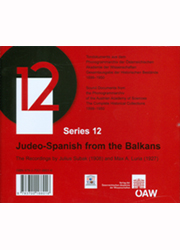
During 1908/1909, Julius Subak (1872–1936), an Austrian Romance scholar, was entrusted by the Balkans Commission of the Imperial Academy of Sciences to record, both in writing and phonographically, the Judeo-Spanish of the Balkan Peninsula. He conducted his primarily linguistic investigation among the descendants of those Sephardim who – expelled from Spain in 1492 – had sought refuge in the Balkans, then part of the Ottoman Empire. The resulting 15 Phonogramme are said to be the first recordings of Judeo-Spanish (or Ladino) made for scholarly purposes. They contain chiefly poems and romances (the orally transmitted ballads from medieval Spain), but also songs and a passionate appeal to preserve the Judeo-Spanish language. Subak even succeeded in recording prominent representatives of Sarajevo´s Sephardic community – such as Abraham A. Cappon, who is reciting from his own works.
In 1927, the US-American Max A. Luria (1891–1966) undertook linguistic field research in Monastir (present-day Bitola, FYROM) as part of his doctoral dissertation. Equipped with an Archivphonograph, he made a total of 26 recordings which – featuring proverbs and dialogues, but above all numerous konsežas (folktales) – bring to life again this particularly conservative dialect of Judeo-Spanish.
The contributions by Aldina Quintana Rodríguez, Edwin Seroussi and Rivka Havassy as well as Paloma Díaz-Mas highlight the importance of these unique sound documents, especially for Judeo-Spanish dialectology, but also for the study of Sephardic music and literature.
Together with the transcriptions, they constitute a valuable supplement to the recorded witnesses of a once flourishing culture on the eve of cataclysmic changes.
2009,
978-3-7001-6601-6
1 Audio-CD, 1 CD-ROM, Booklet mit 76 Seiten,
OEAW PHA CD 28